Table of Contents
From ancient myths of mechanical beings to Boston Dynamics’ terrain-crushing robots, you’ve witnessed an epic technological evolution. Imagine da Vinci’s mechanical knight giving way to Shakey, the first reasoning robot. Industrial machines transformed manufacturing, while AI made robots learn and adapt. Humanoid robots now navigate complex environments, make independent decisions, and blur the lines between machine and intelligence. Curious about what’s next? Stick around.
Ancient Automata: The Earliest Mechanical Marvels
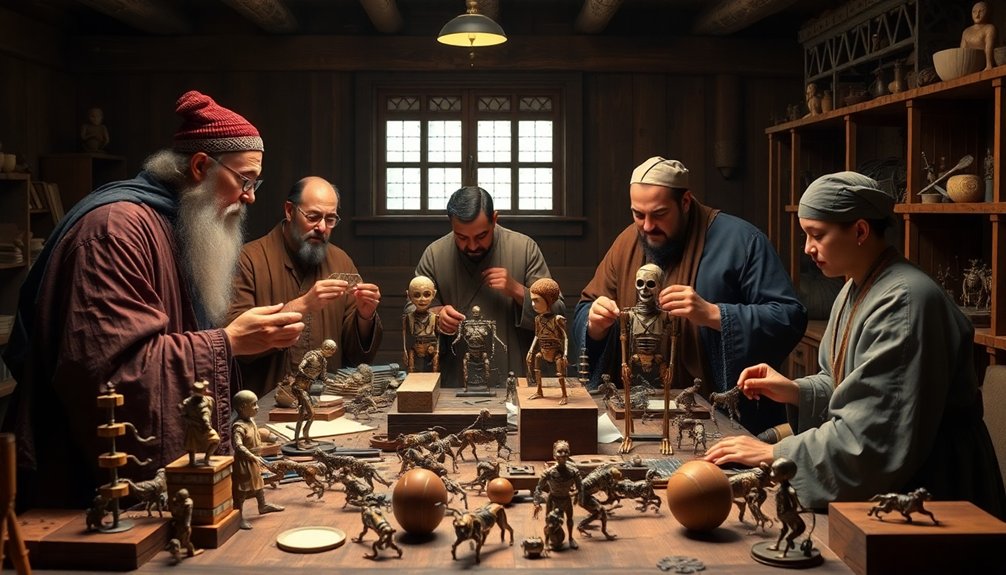
Ever wondered where our obsession with mechanical humans really began? Ancient Greeks weren’t just about philosophy and sandals—they were robot pioneers.
Picture Hephaestus crafting bronze automatons in his mythical workshop, or Talos, the massive bronze guardian protecting entire civilizations. These weren’t just myths; they were early blueprints for humanoid machines.
Inventors like Daedalus and Ktesibios were playing with quicksilver and water-powered mechanisms centuries before computers existed. The Great Library of Alexandria became ground zero for mechanical innovation, with brilliant minds like Hero designing programmable carts and complex hydraulic systems.
Ancient minds engineered ingenious machines, transforming water and mercury into programmable mechanical wonders.
These weren’t just toys—they were sophisticated technological demonstrations that proved humans could engineer intelligent, moving machines. Mechanical System Design revealed that automata were more than mere curiosities, representing complex engineering principles that would influence technological development for centuries to come. Mythological Bronze Figures like Talos demonstrated that ancient civilizations were capable of imagining complex mechanical beings far beyond their technological capabilities.
Sounds familiar? That’s because every robot today carries the DNA of these ancient mechanical marvels.
Da Vinci’s Mechanical Designs: Pioneering Robotic Concepts
You’ve heard of Leonardo da Vinci as an artist, but did you know he was basically the world’s first robotics engineer?
His obsessive human anatomy sketches weren’t just about painting pretty pictures—they were mechanical blueprints for understanding how bodies actually move and function. In fact, his pioneering work included creating a mechanical humanoid knight that could perform complex movements using an intricate system of pulleys and gears. Da Vinci’s autonomous self-propelled cart is considered the earliest known example of a programmable machine, demonstrating his incredible mechanical ingenuity decades ahead of his time.
Mechanical Movement Inspiration
When Leonardo da Vinci sketched his legendary mechanical knight in the late 15th century, he wasn’t just doodling — he was blueprinting the future of robotics.
Using pulleys, cables, and gear systems, da Vinci created a humanoid that could sit, stand, and move its arms like a medieval transformer. Mechanical control systems allowed the robot to operate with unprecedented complexity for its time. His understanding of joint kinetics and motion demonstrated remarkable insight into the fundamental principles of mechanical movement.
Imagine a German-style armored robot performing gestures centuries before computers existed! His mechanical designs weren’t just engineering tricks; they were radical visions of what machines could become.
By studying human anatomy and applying basic physics principles, da Vinci proved that robots could be more than clunky machines — they could mimic human grace and complexity.
His innovative mechanical knight design represented a groundbreaking approach to understanding biomechanical movement and machine articulation.
Who would’ve thought a Renaissance inventor would lay the groundwork for today’s cutting-edge robotics?
Human Anatomy Sketches
Anatomy wasn’t just a science for Leonardo da Vinci — it was an obsession that would revolutionize how we comprehend machines. His sketches weren’t just drawings; they were mechanical blueprints of human potential.
Consider how he decoded our biological machinery:
- Dissected bodies revealed intricate movement systems
- Geometric proportions mapped human mechanical design
- Body parts became interchangeable machine components
Da Vinci saw humans as walking, breathing robots long before technology caught up. He’d slice through flesh, sketch every muscle fiber, and ask: What makes us move? Anatomical layered drawings allowed him to visualize the body’s mechanical interconnections with unprecedented depth and precision. His meticulous night-time anatomical investigations illuminated the body’s mechanical complexity with an unprecedented scientific precision.
His radical approach transformed anatomy from a passive study into an active engineering challenge. By treating the human body like a complex machine, he planted seeds for modern humanoid robotic design that would inspire generations of engineers and inventors.
Who’d have thought centuries-old sketches would become the grandfathers of today’s humanoid prototypes?
Robotic Design Foundations
Because mechanical knights weren’t exactly strolling around Renaissance Italy, Leonardo da Vinci’s robotic designs were basically the sci-fi fever dreams of a genius engineer centuries ahead of his time. Mechanical control systems enabled complex movements through an innovative network of pulleys and gears that translated human-like articulation.
His mechanical knight wasn’t just a cool toy—it was a groundbreaking prototype using pulleys, gears, and cable systems that mimicked human movement. Imagine a robotic figure that could sit, stand, and wave its arms like a medieval Terminator, all powered by an intricate anatomical design that blended engineering with biological insight. Early automaton pioneers like Kaufmann would later build upon these revolutionary conceptual foundations.
Da Vinci’s automata weren’t just mechanical curiosities; they were revolutionary concepts that hinted at future human-machine interactions. Ethical design principles guided his inventive process, ensuring that his mechanical creations balanced technological innovation with human-centric considerations.
Who knew a Renaissance artist could basically predict robotics centuries before computers? His designs laid the groundwork for everything from surgical robots to NASA’s most advanced machines.
Shakey the Robot: First Reasoning Autonomous Machine
The robot that launched a thousand AI dreams shuffled onto the scene in the late 1960s: Shakey, a gangly electronic pioneer that would forever change how machines think and move.
At SRI International, this groundbreaking machine proved robots could be more than just mindless automatons by demonstrating unprecedented reasoning capabilities:
- First mobile robot to use AI for environmental decision-making
- Capable of understanding and executing complex English commands
- Navigated spaces independently while solving intricate problems
Imagine a clunky metal creature analyzing its surroundings, planning routes, and moving objects—all without human micromanagement.
Metal brain meets mechanical body: autonomy unleashed, intelligence reimagined without human strings attached.
Shakey wasn’t just a robot; it was a glimpse into a future where machines could think, adapt, and interact intelligently.
DARPA’s funding transformed this shaky innovator into a landmark achievement that would inspire generations of roboticists and AI researchers, proving that intelligence isn’t just human—it’s programmable.
With the emergence of cognitive engines, Shakey’s rudimentary reasoning paved the way for future robots to process knowledge in real-time and make adaptive decisions.
Industrial Revolution of Robotics: Manufacturing Transformation
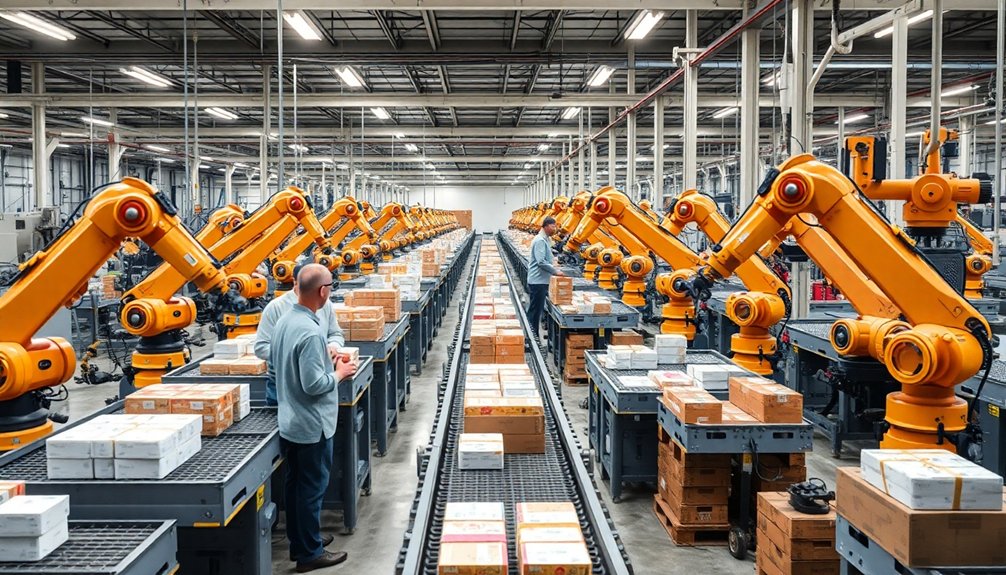
While early robots looked like oversized metal toys with limited capabilities, the industrial revolution of robotics transformed manufacturing faster than anyone could’ve predicted.
Imagine massive metal arms swinging through factories, replacing humans in dangerous and repetitive tasks. The Unimate robot kicked things off in 1961, showing manufacturers that machines could handle the grunt work without complaint.
By the 1970s, microprocessors turbocharged robot capabilities. Suddenly, these mechanical workers could learn, adapt, and perform increasingly complex operations.
Collaborative robots—or “cobots”—emerged, working alongside humans instead of replacing them entirely. They became precision machines that could lift heavy loads, weld with pinpoint accuracy, and never take a coffee break.
The result? Manufacturing got smarter, safer, and way more efficient. Warehouse robotics market is projected to reach $17.98 billion by 2032, demonstrating the massive economic potential of robotic transformation.
Boston Dynamics’ Big Dog: Terrain-Conquering Quadruped Innovation
Imagine robots that don’t just stand around in factories, but actually march through terrain that would make human soldiers think twice. Boston Dynamics’ BigDog is that robotic game-changer, a mechanical mule designed to conquer impossible landscapes.
Check out its wild capabilities:
- Carries 340 pounds across mud, snow, and rocks
- Runs at 4.4 mph with hydraulic precision
- Climbs 35-degree slopes without breaking a sweat
This quadruped isn’t just another tech toy — it’s a potential revolution in military logistics and rescue operations.
With 16 hydraulic actuators and an array of sensors, BigDog can navigate environments that would make traditional vehicles cry uncle. It’ll jump obstacles, recover from pushes, and keep moving when wheeled machines would get stuck.
Who needs a Jeep when you can have a robot that thinks like a mountain goat?
NASA’s Robonaut 2: Human-Like Assistants in Space
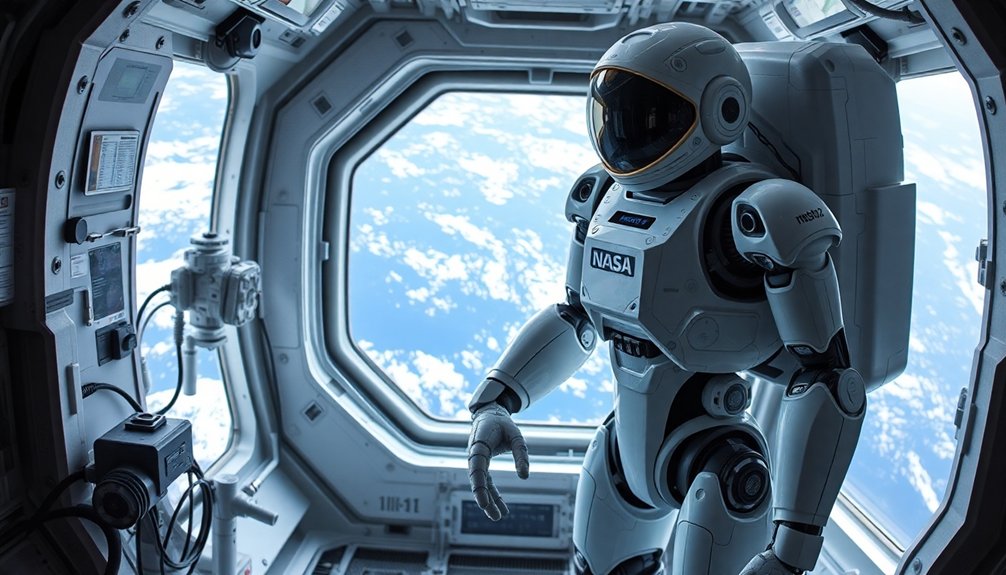
Want to know the coolest part? NASA and General Motors collaborated to create this mechanical marvel, proving robots aren’t just sci-fi fantasies.
From potential land mine detection to bomb disposal, Robonaut 2 isn’t just changing space exploration—it’s reimagining human-robot teamwork.
Self-Replicating Robots: Breakthrough in Autonomous Reproduction
Building on NASA’s groundbreaking work with Robonaut 2, where human-like machines tackle complex tasks, scientists are now pushing technological boundaries into even wilder territory: robots that can make copies of themselves.
These self-replicating machines aren’t sci-fi fantasy—they’re emerging technology with mind-blowing potential:
Self-replicating robots: transformative technology bridging science fiction’s wildest dreams with tangible, revolutionary innovation.
- Autonomous robots gathering raw materials
- Manufacturing their own replacement parts
- Adapting to complex environmental challenges
Imagine swarms of mechanical creatures roaming landscapes, rebuilding themselves like biological organisms. They’ll solve problems we can’t even anticipate: exploring hostile planets, repairing infrastructure, or regenerating after catastrophic damage.
But don’t get too excited. These robots aren’t perfect. They’ll need sophisticated error-correction mechanisms and complex algorithms to manage their reproductive processes.
Can they genuinely become independent? The jury’s still out—but the possibilities are tantalizing.
Artificial Intelligence Integration: Robots That Learn and Adapt
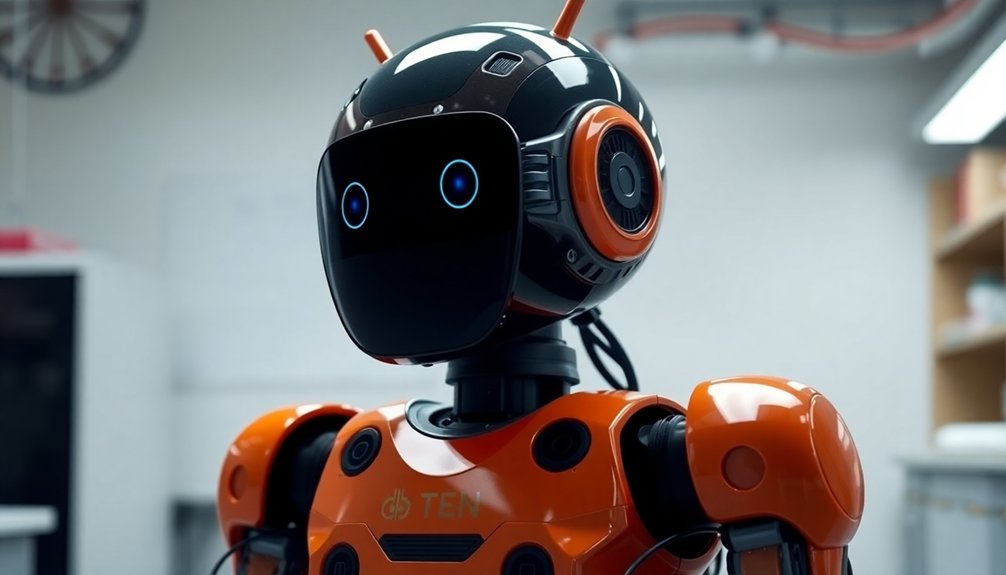
You’ve probably wondered how robots go from mindless machines to something that can actually learn and adapt, right?
Machine learning is the secret sauce that transforms clunky robots into intelligent systems that can figure things out on their own, fundamentally teaching themselves new tricks through trial and error.
Machine Learning Fundamentals
Imagine robots as perpetual students, constantly absorbing and adapting to the world around them—that’s the promise of machine learning in humanoid robotics.
You’re witnessing a technological revolution where robots aren’t just programmed; they’re learning.
Consider these game-changing approaches:
- Supervised learning lets robots recognize objects like seasoned detectives matching fingerprints.
- Reinforcement learning transforms robots into trial-and-error experimenters, refining skills through rewards and penalties.
- Deep learning creates neural networks that mimic human brain complexity, enabling unprecedented decision-making.
Adaptive Robotic Intelligence
Some robots are about to get seriously smart—and not just in a pre-programmed, predictable way.
Imagine machines that learn, adapt, and make decisions without constant human hand-holding. These aren’t sci-fi fantasies; they’re emerging technologies that blend AI with robotic systems.
Think of them like digital chameleons, shifting strategies in real-time based on environmental challenges. Evolutionary algorithms are teaching robots everything from complex walking patterns to intricate manipulation skills.
They’re not just following instructions—they’re problem-solving on the fly. But here’s the kicker: while these adaptive robots promise incredible productivity and safety improvements, they also raise fascinating questions.
Can machines genuinely understand context? Will they replace human workers?
One thing’s certain—the robotic revolution isn’t coming. It’s already here, and it’s learning faster than you might think.
Bioengineering Breakthroughs: Lifelike Robotic Features
As bioengineering pushes the boundaries of humanoid robotics, we’re witnessing a radical transformation in how machines mimic human characteristics.
Consider these breakthrough features:
- Lifelike skin that responds to touch and temperature
- Neural networks mimicking human decision-making processes
- Adaptive movements that blur the line between machine and organism
Your future robotic companions won’t just look human—they’ll think and react like humans too.
Researchers are cracking the code of biological motion, developing materials that flex and respond with unprecedented complexity.
Imagine robots that can sense your mood, adjust their behavior in milliseconds, and move with a grace that makes you forget they’re artificial.
The line between human and machine? It’s getting thinner by the day.
And that’s both thrilling and slightly unnerving.
Autonomous Systems: Robots Making Independent Decisions
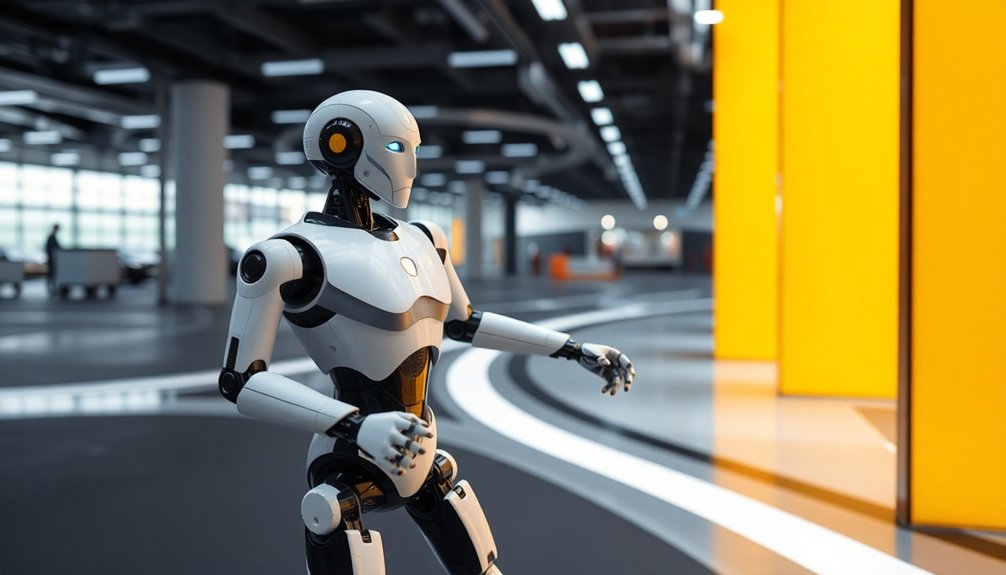
You’ve probably wondered how robots can learn to think for themselves, and machine learning is the secret sauce that’s making it happen.
Imagine a robot that can navigate complex environments, adapt to unexpected challenges, and make split-second decisions without human intervention—that’s the cutting-edge promise of autonomous navigation systems.
These aren’t your grandpa’s pre-programmed machines; they’re intelligent systems that learn, improve, and surprise you with their ability to tackle tasks you’d never expect a machine could handle.
Machine Learning Autonomy
When machine learning meets robotics, something magical happens: robots start thinking for themselves.
They’re evolving from programmed machines to intelligent decision-makers through incredible technological leaps:
- Neural networks now enable robots to recognize complex patterns.
- Real-time processing allows split-second autonomous choices.
- Advanced sensors provide robots with near-human environmental perception.
Imagine a robot that learns from its mistakes, adapts to new situations, and makes decisions faster than you can blink.
Machine learning isn’t just teaching robots to do tasks—it’s giving them the ability to understand context, predict outcomes, and act independently.
They’re no longer simply following instructions; they’re interpreting, analyzing, and responding like intelligent beings.
The line between programmed behavior and authentic reasoning is blurring, and we’re witnessing the dawn of truly autonomous robotic intelligence.
Adaptive Navigation Systems
Because robots aren’t just fancy remote-controlled toys anymore, adaptive navigation systems represent the bleeding edge of autonomous machine intelligence.
Imagine a robot that can dodge obstacles, recognize faces, and make split-second decisions without a human pulling the strings. Modern humanoid robots like REEM are proving that autonomous navigation isn’t sci-fi—it’s happening right now.
These machines use integrated sensors and advanced algorithms to map environments in real-time, fundamentally giving them robotic street smarts.
They’re learning to interpret complex spatial data faster than you can blink, transforming from clunky machines into agile problem-solvers.
Want proof? Look at how service robots now navigate warehouses, hospitals, and even your living room with shocking precision.
The future isn’t just coming—it’s already walking among us.
People Also Ask
Are Humanoid Robots Dangerous to Humans and Our Existing Workforce?
You’ll face both risks and benefits with humanoid robots. They can reduce workplace injuries but might displace workers and require new skills, demanding careful integration and ongoing safety management.
How Much Do Advanced Humanoid Robots Currently Cost?
Imagine XPeng’s Iron Robot at $150,000. You’ll find advanced humanoid robots currently cost between $10,000 for basic models and $200,000 for industrial-grade units with cutting-edge AI, sensors, and multi-purpose capabilities.
Can Humanoid Robots Develop Genuine Emotions or Consciousness?
You can’t expect humanoid robots to develop genuine emotions or consciousness right now. They’re programmed to mimic emotions, but they don’t actually experience them like humans do.
Will Humanoid Robots Eventually Replace Human Workers Entirely?
You’ll witness a massive workforce revolution, but total human replacement isn’t likely. Humanoid robots will transform industries, creating new jobs while augmenting human capabilities through specialized, collaborative roles.
What Ethical Considerations Exist in Developing Increasingly Sophisticated Robots?
You’ll need to balance technological advancement with ethical safeguards, addressing potential job displacement, privacy risks, and ensuring robots don’t perpetuate harmful biases while maintaining human-centric values.
The Bottom Line
You’ve watched robots evolve from mechanical toys to thinking machines. The future isn’t just coming—it’s already here, walking, learning, and reshaping our world. And while we’re not quite living in a sci-fi movie, robots are proving they’re more than just fancy gadgets. They’re revolutionizing everything from surgery to space exploration. Buckle up: the robotic revolution is just getting started.
References
- https://mikekalil.com/blog/humanoid-robot-timeline/
- https://www.aventine.org/robotics/history-of-robotics/
- https://www.youtube.com/watch?v=ckVr2EIb1uU
- https://www.uti.edu/blog/robotics-and-automation/the-definitive-timeline-of-robotics-history
- https://nieonline.com/tbtimes/downloads/supplements/robotics_timeline.pdf
- https://themadmuseum.co.uk/history-of-automata/
- https://en.wikipedia.org/wiki/Automaton
- https://futura-automation.com/2019/05/15/a-history-timeline-of-industrial-robotics/
- https://thereader.mitpress.mit.edu/the-ancient-history-of-intelligent-machines/
- https://www.gwsrobotics.com/blog/history-of-robots
